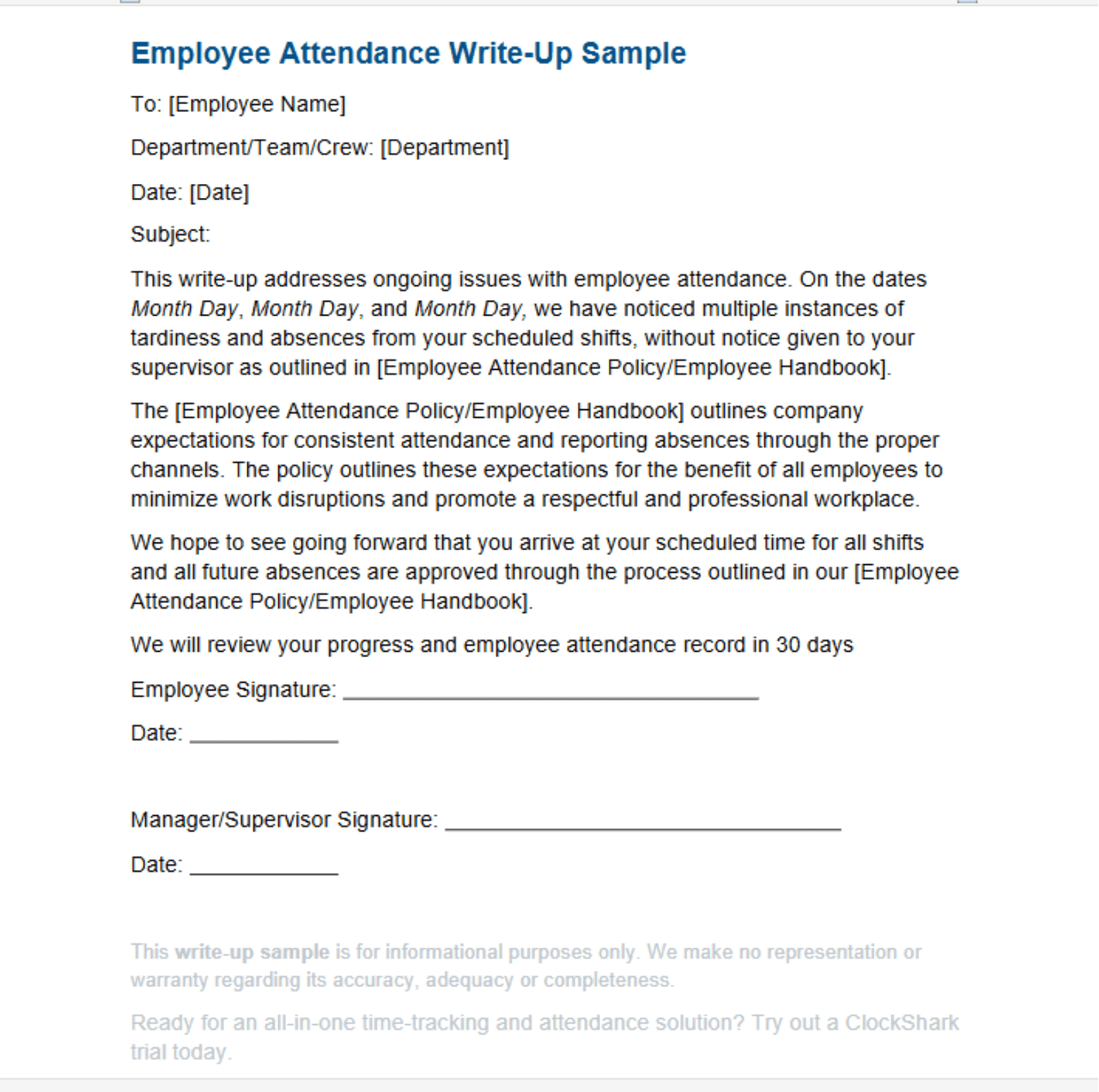Having a perfect attendance record is almost impossible for most people. Everyone will have their off days and come in late. When people have perfect attendance for years, it’s so surprising that they get on the news!
That doesn’t mean you can’t encourage the best from your team and build a healthy, efficient and productive workplace. One essential factor is consistent employee attendance.
When do you require an employee attendance write-up?
Different kinds of absences and tardiness can occur in your team. Some are reasonable and justified, such as planned, approved PTO and sick leave. Providing an attendance policy as part of employee onboarding will outline expectations and policies regarding reasonable/excused absences. For example, providing doctor’s notes or calling in when running late can contribute to an excused absence.
But what happens when someone calls in every Monday morning? Is sick leave ongoing without documentation? Or are they clocking in 10 minutes late every day?
Recognizing Patterns of Absenteeism and Tardiness
When absences and lateness turn from one-off, occasional occurrences, or an employee stops following attendance policy procedure (for example, not calling their direct supervisor to notify them of a late arrival or absence), you will require an employee attendance write-up.
Excessive absenteeism and tardiness are patterns of unexcused absences, and noticing these in an employee’s attendance record or hearing it from their supervisor and team can indicate a serious issue.
It’s times like that when you’ll need an employee attendance write-up sample to prepare and issue an official warning.
Evaluating the Impact on Team and Productivity
Your team works hard, and adhering to schedules is key to keeping jobs and projects running smoothly. Field service businesses are very aware of how a small delay can have a domino effect on current and future jobs. Tardiness, sudden absences and no-call no-shows all impact productivity.
Patterns of absences aren’t just an individual issue; they affect the whole team’s morale and productivity. This affects everyone if a worker is consistently late or misses shifts without notice. Taking on extra work for a missing team member slows projects and can cause higher rates of burnout.
If a team member is hurting the rest of the team and overall productivity, it’s likely time for an employee attendance write-up.
Unacceptable Attendance against expectations and policies
As a business, you have reasonable expectations for your employees, just as they have reasonable expectations of you as an employer. Company policies outline your and workers’ responsibilities for an effective, safe and positive workplace.
An employee attendance write-up sample
Our Employee Attendance Write-Up Sample

Steps for implementing an attendance write-up sample
Now that you have an employee attendance write-up sample to work with, we’ll cover the steps to implement write-ups effectively.
Keep all communications professional and respectful throughout a write-up and disciplinary action. Most situations regarding tardiness or unexcused absences are an opportunity to improve employee productivity and communication; approaching the situation with professionalism and fairness fosters the behavior and attitudes you want to see in your team.
Accusations will make a team member defensive: approach with the intention of consistency and respect for everyone’s time. Reflect this respect in your employee attendance write-up sample and present it as a fair warning.
1. Gather necessary documentation
Necessary documents should include the employee’s attendance record, noting the relevant days/shifts where absences/tardiness were recorded.
If you have previous conversations regarding the employee’s attendance issues, make notes or copies of the details. This will assist in discussing previous attempts to rectify the situation and demonstrate that an employee attendance write-up isn’t pulled out of thin air.
As a side note, when team members or supervisors mention attendance issues, it’s better to discuss them in writing for future reference. For verbal conversations, note the time and date.
2. Review company attendance policies
Reviewing the policies your business has set in place is essential for an effective employee attendance write-up. Note which policies have been affected.
Comparing the relevant policies with the noted attendance issues gives your employee attendance write-up sample a solid foundation. It shows that it is based on a consistently applied set of expectations for every team member.
3. Draft the write-up
With your information and documentation in hand, prepare a draft with your employee attendance write-up sample.
First, address the nature of the issue that your business has noticed. Our employee attendance write-up sample covers a pattern of unexcused absences/tardiness. Include the section/part of your company’s attendance policy that the worker violated.
Be sure to include the specific instances of unexcused absences/tardiness and the dates. Additional information, such as emails/conversations about previously discussed tardiness, can be added when relevant.
We've included a signature section in our provided employee attendance write-up sample.
4. Schedule a meeting with the employee
One of the purposes of your employee attendance write-up sample is to foster productive communication with your employees and have expectations made clear. In this vein, scheduling time with the employee to issue the write-up and discuss the details will give them another opportunity to discuss and understand the problem.
Schedule a meeting in a private place that will minimize disruptions to the employee and the team. You’ll encourage your employees to do the same by setting professional and respectful standards.
Signing off on the employee attendance write-up sample ensures that your business and the employee are on the same page and that the employee acknowledges and understands attendance expectations.
5. Set a timeline for improvement and schedule follow-up
Setting a time period within your employee attendance policy assists with this: setting a 30-day or 60-day period, for example, provides a clear timeline for workers to follow when tracking their attendance, absences and warnings.
Including a timeline or review in your employee attendance write-up sample provides the opportunity for improvement from a team member.
How do you follow up on an employee attendance write-up?
Hopefully, our employee attendance write-up sample will assist your business with the warning process. But what can your business do to ensure effective follow-up and improvement?
Monitor Attendance
Monitoring employee attendance for a set period after the write-up date is standard to ensure that the worker in question follows expectations.
Review timesheets for worker clock-in and clock-out times, ensure the employee follows their schedule, and check in with their supervisor/manager. Need timesheets? ClockShark has you covered with our timesheet templates. Proper attendance includes giving proper notice and following your employee attendance policy when absent.
At the end of the nominated period, schedule another meeting with the employee for review and feedback. In many cases, employees will make a concerted effort to get back on track and adhere to attendance expectations (especially if they know there’s a review coming up!).
Support and Resources
Some patterns of absences/tardiness can be due to personal circumstances, burnout or medical reasons. An employee attendance write-up sample is flexible and can cover a variety of situations. Sick leave without warning or notice can become an unexcused absence, which is why it’s so important to touch base with employees and keep communication open.
Employees may need further support, such as accommodations for sick leave, working conditions, or general well-being. Excessive absenteeism could indicate low morale among the crew, so supporting employee wellbeing is vital.
Further Disciplinary Action
Usually, a write-up and follow-up review are enough to address attendance issues, but not always. Unfortunately, some workers will continue their patterns. This is an issue for your business, as even instances that seem ‘small’ to a team member, such as regularly being 15 minutes late, add up in the long run. 15 minutes, an hour, a day—they all constitute time theft.
Further disciplinary action may have different steps depending on your employee attendance policy. One step is to deny bonuses or additional PTO. A second employee attendance write-up is another common step.
Make it clear that if the employee continues to have attendance issues, their behavior could lead to termination.
Ensure consistency with an employee attendance write-up sample
Good attendance is about consistency. When the team is consistent, your business can trust them to be on time and where they need to be, or let you know ASAP when they can’t.
An employee attendance write-up sample can help you communicate and address attendance issues that come your way with respect and professionalism. Even warnings can contribute to a fair and healthy workplace when workers consistently see policies being implemented.
Trust is a two-way street, and we hope our employee attendance write-up sample helps you build that trust and continue growing your business!
Frequently asked questions about employee attendance write-up
What are the legal considerations when writing up an employee for attendance issues?
It’s important to follow legal requirements for sick leave and PTO; if your employee attendance write-up concerns these issues, ensure that you focus on the employee needing to follow company policy for getting approved PTO or properly notified of absences.
Sick leave can be required for many reasons, and some employees require it for chronic illnesses or disabilities. In these cases, it’s essential to abide by the Americans with Disabilities Act (ADA) and make reasonable accommodations if required.
How can I address attendance issues caused by personal or medical problems?
Absences can occur for various reasons, but your employees need to understand that no matter the reason for their absences/tardiness, your business has policies and expectations that apply to everyone equally.
If an employee has attendance issues due to these problems, communicate with them that absences can’t be excused if your company’s employee attendance policy isn’t followed. Reasonable time-off and sick leave can’t be issued if your business hasn’t been properly notified, after all.
Keep communication open, professional and respectful.
What steps can I take to improve overall attendance in the workplace?
Fostering a healthy company culture and a safe work environment for your team can improve attendance. Safe workplaces mean less time lost to injuries and accidents and less burnout.
Your employee attendance policy is useful; your employees must know about it! The team should know that good attendance isn’t just about turning up but following procedures when they can’t. The policies allow everyone to access sick leave and apply for PTO when they need it.
PTO, sick leave and excused absences are essential to a productive workplace. It might seem counterintuitive: they’re not coming in, so how can they be productive? It’s about balance. People need time to recharge, and having time available in the first place boosts morale and overall worker satisfaction.
And of course, reward good attendance! Employees will be more encouraged to adhere to attendance policies if they get a direct benefit and feel appreciated. Additional PTO days, lunch vouchers or bonuses are good motivators.





